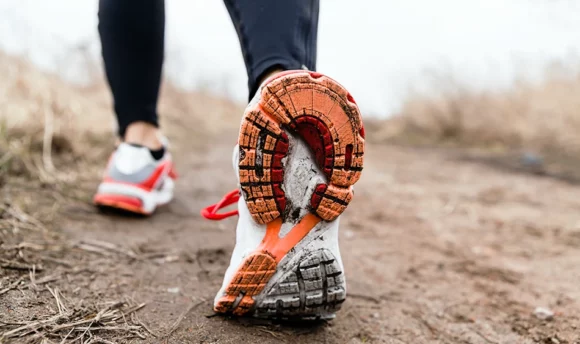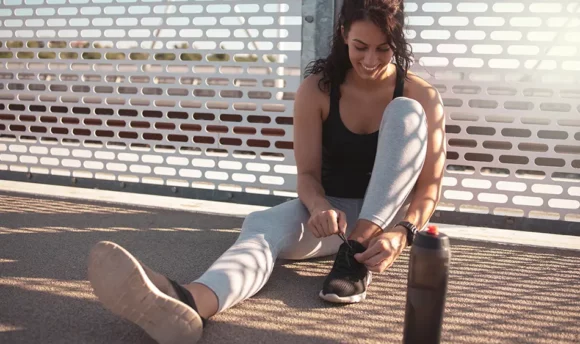How to Run a Faster Mile? 10 Tips That Will Improve Your Results
Not noticing any progress in your mile time? There are changes you can make to both your lifestyle and training plan that can get you back on the fast track.

Maybe you’re an avid runner wanting to get ready for a race or a running enthusiast looking to improve your mile pace. Either way, making changes to your training plan and lifestyle habits will be a big part of you getting the results you want.
In this article, we will be outlining 10 changes that can help set you up to run a fast mile and reach all your fitness goals.
How Long Does It Take to Run Faster?
How long it will take you to run faster will depend on how consistent you are with your exercises, as well as how much you push yourself during your workouts.
After a week or two of consistent workouts, you should notice that your workouts start becoming easier and that you are able to run farther without needing a break.
For you to begin improving your mile time, chances are it will take longer than a few weeks for you to notice any change. Give yourself 6–8 weeks for you to build up your speed and endurance in a way that is healthy and safe for your body.
In the beginning, it’s best not to focus on good mile time. Instead, focus on increasing your muscle strength and perfecting your running form. These differences will help you create the most noticeable change over the long term.
10 Tips on How to Run a Faster Mile
If you want to improve your mile pace, there are definitely tips and techniques you can make use of to do so. Not sure what mile time you should even be aiming for? This article can give you all the information you need, taking into account things like your age and ability.
1. Build running endurance
The best way for you to build your running endurance is to choose a training plan and stick with it. There is no quick fix when it comes to improving your cardiovascular health, which is a key component in building your running stamina.
A good way for you to improve your running stamina is to focus on improving your lactate threshold. Your lactate threshold is the sweet spot in between aerobic and anaerobic respiration where your muscles are still oxygenated but are being pushed to their limit.
In order for you to cater your workouts to stay in this particular range, you will need to invest in a heart rate monitor.
Start by figuring out an approximate of your maximum heart rate by subtracting your age from the number 220. Your lactate threshold sits somewhere between 70–85% of your maximum heart rate.
Working out in this zone will help you build your aerobic endurance, helping you run faster and for longer.
2. Keep the running consistency
The most difficult thing when starting a new running program is staying consistent; to not overburn, try running not more than 5 times per week. When we are starting something new, we tend to set goals that are ambitious, which is great!
But when our goals are too ambitious, it can cause us to fail early on, and sometimes, one week without workouts can turn into a month of no exercise before we know it.
If consistency is something you struggle with, then finding another way to hold yourself accountable will be important.
Apps like Joggo help you to pre-plan your workouts for the week, which can help you stay on track, even when you’re tempted to skip a day.
Not only that, but they create personalized running plans for you to follow, created especially for you, with your current level of fitness in mind.
This means you won’t take on more than you are ready for too soon, resulting in you having to take time off due to overuse injuries.

- Personalized running plans created by professional coaches
- Meal plans perfectly tailored to your current diet, allergies, and health needs
- Treadmill mode for people preferring indoor running
- Educational articles on easier running, injury prevention, nutrition, and more
- Behavior science-based reward system for lasting motivation
3. Try new types of running workouts
When your current workout stops getting results, it’s important to start switching things up. Trying a new training plan can help you improve muscle strength and endurance, which, in turn, will help you run a faster mile.
Sprints
Sprint training is one of the best ways for you to improve your running speed. This is because it is an anaerobic exercise. Every time you do it, you train your body to process lactic acid more quickly.
An example of a sprint training session would be a 30-second sprint at your maximum effort, followed by a 90-second recovery walk, repeated at least 5 times.
Tempo run
A tempo run can help improve your lactate threshold. It is meant to be done at the same pace, somewhere between 70% and 85% of your maximum heart rate. These runs should last at least 20 minutes and can be extended up to an hour for more advanced runners.
Interval run
Interval training is a good way for you to push your body and start noticing results. Interval runs don’t have a certain structure but are generally a high-intensity run followed by light jogging for cool down, repeated multiple times. An example of an interval run would be running half a mile at a quick and steady pace, followed by a quarter-mile jog, repeated 5 times.
Fartleks
Fartleks are a more open-ended form of interval training and are ideal for anyone not tracking their mileage. An example of a fartlek is choosing an object in the distance for you to sprint to, followed by another object of your choosing for you to walk or do a light jog to, rinse and repeat.
Progression run
A progression run is great to use to challenge your mental stamina as well as your physical endurance. An example of a progress run would be to run for 45 minutes, the first 15 minutes at a slow pace, the next 15 at an increased pace, and the last 15 as fast as your body can handle without having to take a walking break.
4. Rid of excess weight
It is recommended that you can run up to 2 seconds faster per mile for every pound you lose.
As you run, you will naturally start to trim down. Losing weight will help you by lessening the load you need to carry with you while you run.
Lifting the extra weight off the ground will not only slow you down, but it will also consume more of your energy, causing you to exhaust faster.
Of course, the important thing to keep in mind here is where your weight is coming from. If you are on the heavy side, but that weight comes from muscle, chances are trimming down won’t have that much of an effect on your running time.
But if your extra weight is “unnecessary body weight,” meaning visceral fat, then losing it will more than likely improve your running time. Running when you are overweight might be hard at first, but as you continue to work out and shed pounds, your workouts will continue to get easier.
Another thing to keep in mind is any other ways that you can limit your weight while you run. Running with heavy shoes, for example, is guaranteed to slow down your mile time.
Investing in lightweight shoes can have a surprisingly positive effect on how quickly you run.
5. Focus on explosive exercises
Explosive training exercises are designed to increase strength and speed, giving you the ability to generate quick bursts of high effort. They build fast-twitch muscle fibers, which allow you to output big, powerful bursts of energy.
Exercises that are considered “explosive” are things like box jumps and squats. Sprinting and hill climbs are both running styles that are also explosive. Focusing on these kinds of exercises will help strengthen the muscles you use to run, which can have a big effect on your pace.
6. Try cross-training
Focusing your effort on exercises other than running might seem counterproductive in reaching your goal mile pace. However, cross-training is actually a great way for you to strengthen your body.
Most runners, at one point or another, will deal with overuse injuries. Cross-training can reduce the physical stress that high-intensity exercises have on your bones and joints.
Some different kinds of cross-training you can do are:
Cycling
Cycling is debatably the best cross-training exercise for you to use in combination with your running routine. It uses most of the same muscles you use for running but is a low-intensity exercise.
Including cycling workouts into your running program will help you build strength in the same muscles you need for running while giving your body a much-needed break.
If you are currently suffering from running-related injuries like shin splints or sore knees, you could try switching to a cycling-focused training plan for a little while.
Apps like Cycling.Diet can help you create an individualized running plan for you to follow, making sure you don’t lose any of your gains and still continue getting yourself ready for a faster mile.
Swimming
Swimming is another low-impact exercise that is great for taking the pressure off your bones and joints. It is also a great cardiovascular exercise that trains the body to use energy more efficiently. Because of this, you can expect to improve your running endurance, setting you up to run a fast mile.
Strength training
Running is a great exercise for increasing muscle growth. The only problem is that this growth often happens in a way that is not balanced between all your muscles.
Oftentimes, when you run, there will be one or two muscles that carry the brunt of your movements. When this happens, it can put unnecessary strain on your joints, causing things like tendonitis.
Generally, muscle imbalances can also cause your stronger muscles to start to overcompensate for the weaker ones. Overtime can cause overuse injuries.
Strength training can help build the muscles that are being underused while you run. This helps even out muscle imbalances and prevents injury to your muscles, bones, and joints in your lower body.
7. Get rid of your bad habits
Other things that could be holding you back from running the fastest mile are your bad habits. The good news is that regular exercise is actually one of the best ways for you to divert your attention and curb your unhealthy cravings.
Eating late at night
Eating a small, protein-rich meal before bed won’t be a bad idea, but more often than not, our pre-sleep snacks aren’t all that healthy.
Eating junk food before bed can raise your blood sugar levels and focus your body’s energy on digesting the food in your belly instead of on muscle repair after a big workout. Not only that but eating before bed can affect your ability to get a full night’s rest.
Smoking
If you want to improve your mile time as well as running distance, smoking definitely won’t help you do so. Smoking is not good for your cardiovascular health because of the negative effects it has on your blood flow.
Smoking makes it more difficult for your heart to pump oxygenated blood to your muscles, which will keep you from being able to sustain high-intensity exercise.
Not drinking enough water
Proper hydration is what keeps your body cool during intense bouts of exercise. This is especially important if you are running outside on a hot day.
It also helps keep your joints lubricated and can even help in cushioning the blow from high-impact exercise like running.
Lastly, if you are experiencing intense cramping or tight calves while you run, it could very well be due to a lack of hydration. Water in your muscles keeps them feeling relaxed and functioning well, in part because they are what allow electrolytes to hold their charge. Electrolytes are an important part of muscle function.
8. Balanced diet
There is no one-diet-fits-all when it comes to running, but there are certain staples that should be included in everyone’s diet when they are doing high-output exercises like running.
Carbohydrates
Many people are afraid of carbohydrates because they associate high-carb diets with being overweight. While eating a surplus of carbs can cause weight gain, the same reason that people tend to avoid carbs is the very reason that runners need them.
When we eat carbohydrates, our bodies break them down into simple sugars that are absorbed into the bloodstream. These sugars, like glycogen, are what our muscles use for fuel when running. Without them, you will suffer from muscle fatigue and low energy during your workout.
A diet full of healthy carbohydrates like quinoa, oatmeal, and potatoes is necessary if you want to have the energy to run a faster mile.
Fruits and veggies
Fruits and vegetables are full of micronutrients that can help set your body up for better stamina and endurance when you run. They can help with energy production during your run and aid in muscle repair when your workout is over.
Protein
Some experts recommend eating between 0.5 and 0.9 grams of protein per pound of body weight. The more you exercise, the more protein you will need to ensure your muscles continue growing instead of having your body break them down to fuel your workouts.
When you run, you create small tears in your muscles. As your body repairs these small tears, your muscles grow not only in strength but also in size. The amino acids found in protein are the building blocks that help repair and maintain muscle tissue.
Not consuming enough protein will cause you to lose muscle mass, which will keep you from being able to run a faster mile.
9. Don’t forget to rest
Proper recovery will be almost as important as your training program when it comes to improving your mile time.
When you rest, you give your body the opportunity to make all the necessary repairs to your soft tissues – things like muscles, tendons, and ligaments. It also gives your body time to remove all the byproducts – like lactic acid buildup – from your muscles.
Pushing your body without taking time to fully recover could result in overuse injuries and keep you from reaching your running goals.
10. Stretch before and after a run
Stretching before you run helps warm your body up and get it ready for exercise. By taking time to warm up any tight muscles, you give yourself the opportunity to use a full range of motion. This can aid in proper form when you run, helping reduce the risk of injury.
After a run, you can expect that your muscles will be full of lactic acid. Stretching can help remove lactic acid buildup, reducing soreness and allowing you to recover more quickly.
A Word From Our Coach
Implementing some of the tips and techniques outlined in this article will help you get that much closer to running your fastest mile.
As with any workout goal, it’s important not to make sacrifices to your health and well-being to reach it.
Improving your mile time should be something you work toward in order to reach your personal best and shouldn’t involve comparison to someone else’s journey.
Make sure you are still working out in a safe way and penciling in enough rest days to keep your body happy and healthy.
Exercise is a form of self-love and should be done with compassion for your body and personal fitness journey.
Bottom Line
In this article, we’ve answered many of the questions you might have about how to run a faster mile, including:
- Building your endurance
- The importance of consistency
- Switching up your running style
- Including cross-training
- Eating a balanced diet
- Getting enough rest
Focus on creating positive changes to your lifestyle habits and training routine. It won’t happen overnight, but eventually, you will run your fastest mile yet.

















































 Select your language:
Select your language: 








